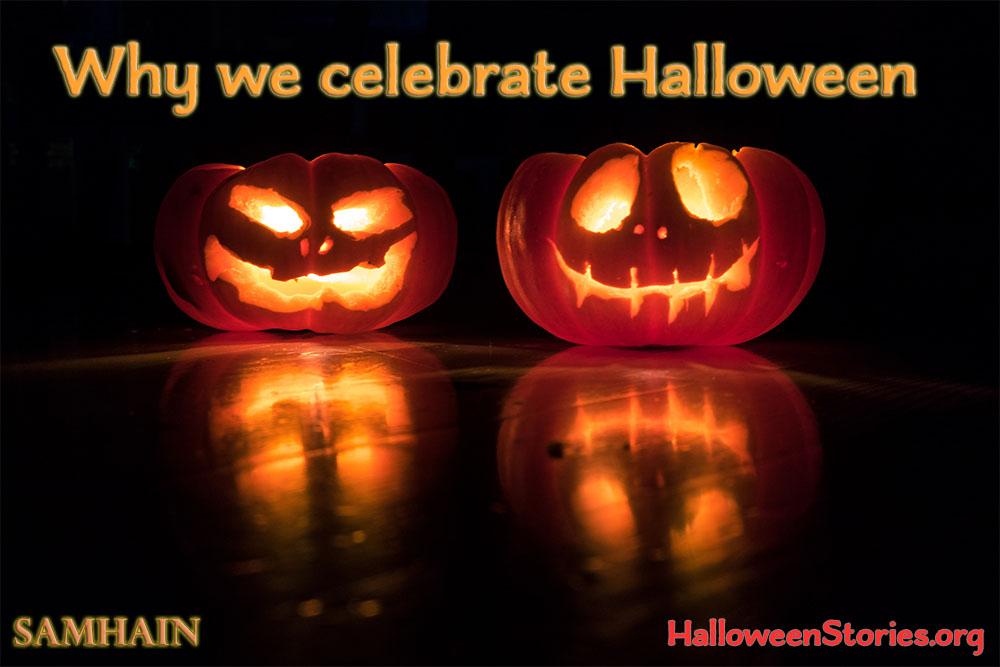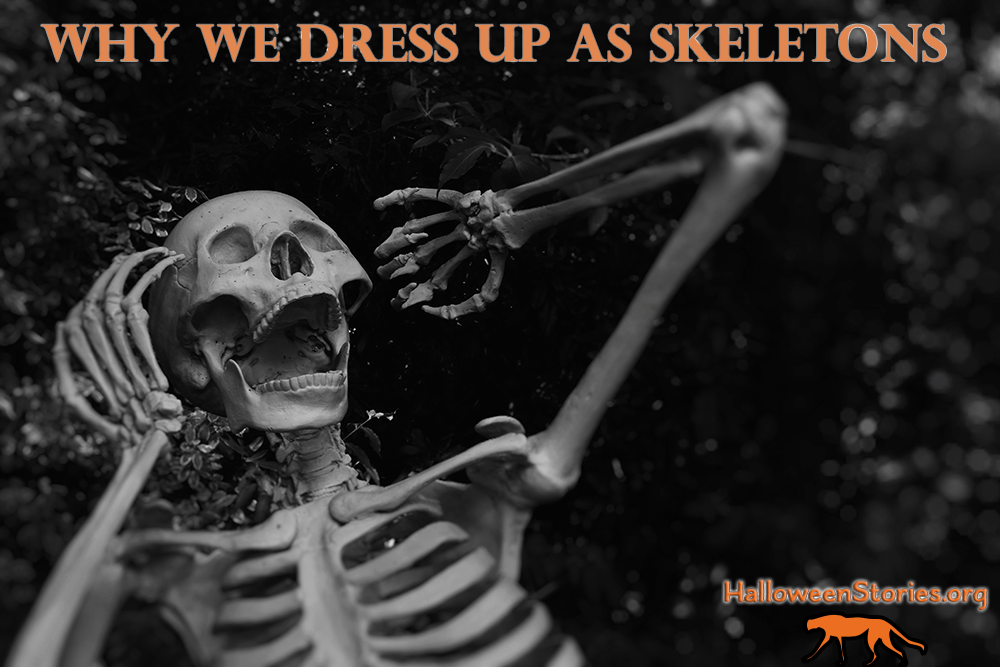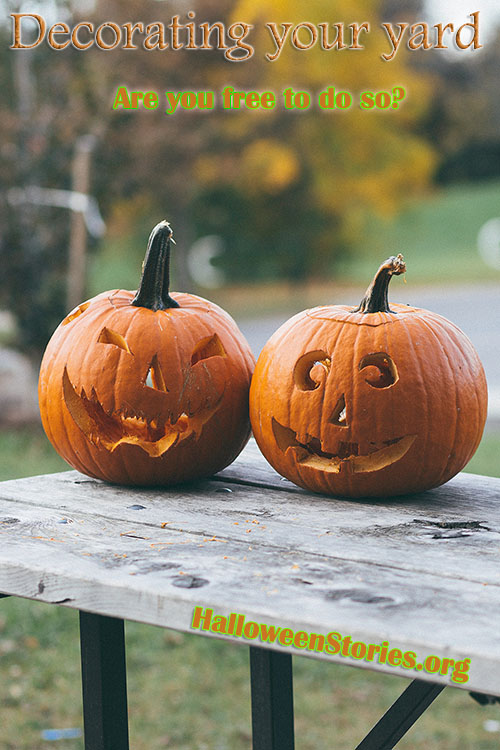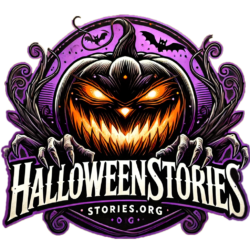October 31st is quickly approaching. As we get ready for another year’s worth of holiday festivities, it’s important that you take a moment to learn about your favorite holiday traditions—and how they came to be. This article will explore the origins of Halloween, why we celebrate Halloween, Halloween in the 1800s, as well as some of its most popular modern-day customs.

Why We Celebrate Halloween
When was Samhain first celebrated?
According to Irish legend, Samhain (pronounced “seem” or “say”) means “summer ending.” It marks the end of summer and the start of winter in Ireland, Wales, Scotland and England. The Celts believed there were only two seasons: Summer and Winter. During Samhain, which falls on November 1st this year, the sun sets on October 31st and does not rise again until around mid-December.
Historians believe Samhain may have been derived from an old Gaelic word meaning “end,” but others say it comes from a Proto-Celtic root *sem-, meaning “to shine”.
What are some fun facts about Halloween?
Legend has it that Samhain was established by Fionn mac Cumhaill (“Son of Cú Chulainn“), one of several legendary heroes who emerged during Ireland’s 15th century Tuatha Dé Danann war against their enemies, the Fir Bolg (ancient Britons). According to Irish mythology, Fionn killed many enemy warriors at night while disguised as a bird called Cathbad mac Morna (“the blackbird king”).
Another story tells of a pagan goddess named Eithne, known as Queen Maeve of Connacht, whose name translates into English as Eve. She lived among the Gaels (Gaelic-speaking inhabitants) before Christianity arrived in Ireland. One autumn evening, she went out trick-or-treating with her daughter Ních Muimhnaigh, also known as Niall No Scalpealla, or Niall of the Nine Hostages. They visited houses where no food had been left over from the harvest season earlier that fall.
When they got hungry later that night, they ate apples because they didn’t know any better. Later, they learned what happened that night was actually bad luck for those who did not leave anything for the fairies.
In addition to apple seeds being considered unlucky, some cultures associate eating pumpkin seeds with death. In fact, according to folklorist David A. Leeming, the phrase, “Don’t eat the pumpkin pie tonight!” dates back to 1881.
Why we celebrate Halloween – Why do we dress up like skeletons?

Many historians agree that traditional costume parties began during the Victorian Era in 19th century Britain. However, other experts claim the practice stems from the early Christian era, when Christians dressed up as martyrs and angels. These types of disguises allowed them to go door-to-door without worrying about harassment or violence.
Fast forward to the 20th century, when American adults started attending masquerade balls at home as part of a trend toward more private celebrations after World War II. But these weren’t just fancy soirees — they often included music and dancing. By the 1950s, wearing costumes became much less controversial than dressing up as characters from films such as Dracula and Frankenstein.
Today, Americans spend $7 billion annually on costumes alone. And the popularity of group gatherings doesn’t seem to be waning anytime soon. According to Nielsen data, 91 percent of U.S. households hosted a party celebrating Halloween last year, including almost half of all millennials.
So why don’t kids want to celebrate Halloween anymore?
Some argue the commercialization of Halloween has contributed to fewer children participating in the event today. For example, Trick-Or-Treat Baskets give candy away door-to-door instead of allowing participants to pick it themselves. Many cities now require residents to display orange safety signs outside their homes.
But others think it might come down to something simpler. Some families simply prefer having their own celebration rather than joining groups organized by churches or schools. With this option, parents can control exactly how long their child spends playing outdoors on Halloween night. There’s also the possibility that younger generations are simply too busy with homework and extracurricular activities to make time for Halloween.
Regardless of the reason, many parents have found ways to keep their children excited about the holiday. Some encourage their kids to participate in community events, such as volunteering at local haunted hay rides, carnivals and parades. Others host special dinners for family members and friends, complete with spooky decorations, games and crafts.
And if you’re looking to bring little ones into the mix, try making costumes yourself together with your kid. You could even bake treats to donate to needy families or shelters. If you need inspiration, here are 10 easy DIY ideas for creating a scary costume.
If you’d still like to experience the thrill of going door-to-door, check out these tips for safe trick-or-treating.
Is it okay to use makeup to look ghostly?
While it’s true that using face paint to create frightening masks is frowned upon by some communities, we’ve seen enough movies and TV shows depicting ghosts and ghouls walking among us to understand that they aren’t really real. Sure, they appear to be made of flesh and blood, but nothing supernatural happens when someone steps inside a movie theater or television set. Ghosts don’t bleed or scream. So, you see, dressing up as ghosts isn’t nearly as terrifying as watching them on film.
However, if you decide to use face paints and makeup to help scare trick-or-treaters, remember that everyone should feel comfortable leaving their mask on once they arrive home. Also, consider asking older siblings or neighbors to watch your house in case anyone gets hurt or feels uncomfortable.
Do I need permission to decorate my yard?

That depends. While homeowners are free to deck their yards with pumpkins, corn stalks and gourds, city officials usually won’t allow decorations to block pedestrian traffic or otherwise harm neighborhoods. Check ahead of time to find out whether your town has specific regulations regarding outdoor decorations.
It seems that every culture celebrates the beauty of life through different holidays and rituals. We hope you enjoyed learning more about the origins of Halloween. Happy haunting!
Modern Day Halloween Traditions
As we move further into the 21st century, we continue to embrace new trends and traditions. Here are some modern-day features associated with Halloween and part of the reason why we celebrate Halloween:
Costume contests: From elementary school students competing for top honors in class to college students vying for cash prizes, Halloween costume contests abound across the country. Whether held at universities, corporations or neighborhood streets, contestants compete for glory, money, trophies and fame.
Spooky songs: Everyone knows “Monster Mash”; however, few recall the lyrics of John Carpenter’s classic tune, “Children of the Corn.” Regardless of age, song requests include tunes like “Are You Afraid of the Dark?” and “Thriller.”
Scary movies & stories: Of course, horror flicks play a big role in getting into the spirit of things. Movies such as Saw, Paranormal Activity, Insidious and Evil Dead 2 provide plenty of scares for both young and old audiences alike.
Haunted Houses: Today, hundreds of thousands visit Haunted Attractions each year. Most offer opportunities to interact with actors and roam freely throughout the grounds. Visitors can enjoy attractions ranging from live entertainment performances to interactive exhibits.
Door-to-door trick-or-treating: Although it wasn’t always the norm, nowadays many communities allow children to walk door-to-door handing out candies and snacks. Parents typically accompany younger tricksters, ensuring proper behavior and safety. Older children receive their own bags filled with items like glow sticks, flashlights and cell phones.
Face painting: Just like clowns used to entertain crowds years ago, artists specializing in temporary facial art fill parks, festivals and streets with color. Creators strive to produce realistic effects using watercolors, oil paints and stencils, along with brushes, knives and glue guns.
Whether you choose to attend a Halloween parade, throw a themed dinner party, show up to a haunted attraction or stay indoors to carve jack-o’-lanterns, carving pumpkins remains a beloved way to add flare to the annual holiday ritual. Be sure to enjoy yourself and continue reading our origins of Halloween article for more details on Celtic legend, why Halloween is on October 31st, and modern Halloween traditions.
Holiday spirit & How it relates to Halloween
When you think about the holidays that are most popular around the world, many will probably come to mind. Christmas is sure to be top on any list followed by Thanksgiving then New Year’s Eve. But what other holiday has become so widespread as to almost completely overshadow all others? That would certainly be Halloween.
While it may not be your first thought when thinking about how much “holiday spirit” there is out there, Halloween is one of those rare occasions where you can find something for everyone. Whether you’re looking for costumes, decorations or just some time with family and friends over a meal, this day is bound to bring some joy! Let’s take a look at why this beloved occasion is such a big deal.
What Is Hallmark?
One thing that makes Halloween special is its association with greeting cards. While they’ve been around since 1839, modern-day Americans didn’t start buying them until after World War II. These days, American Greetings sells more than 1 billion annually while Hallmark comes close behind with 800 million. Both companies continue to dominate the industry, but their rise began during this period.
As these two card giants grew into popularity, they eventually became synonymous with the season itself. So, if you go online and search for either company, chances are good you’ll see a huge selection of items related to the holiday. Some might even call it an official part of our culture now.
But let’s get back to Halloween celebrations & the origins of Halloween. What exactly does this annual event represent? Well, the name actually means All Hollows Day which was likely named because the word hollow refers to caves or shelters. However, due to superstitions surrounding witches and black magic, nocturnal gatherings were discouraged. This meant turning night into day, hence trick-or-treating.
Nowadays, however, festivities like parades, parties, costume contests and games are common throughout North America, Europe, Australia, Asia, Africa and South America. In fact, you could argue that Halloween is celebrating more than its namesake festival ever did.
The Origins of Halloween
In order to fully understand the origins of Halloween and how Halloween evolved, we must first examine the origins of Samhain, also known as All Saints’ Day, November 1st. Back in 325 AD, Pope Gregory decided to create new calendar months based off existing ones instead of simply adding additional numbers to make up January through December. As a result, October became dedicated to saints who had died (hence the term holy).
By 500 AD, Christians started referring to November 2nd as All Saints’ Day. Because this date fell near Christmastime, it took several centuries before pagans adopted the same idea. By 400 AD, Germanic tribes had already begun celebrating Novuvalis Maior, literally meaning “the greater new month.” Eventually, Celts added three extra names to give us November’s leer, Verzemeltesre, and Kneelmester. When combined with the Roman Catholic Church’s calendar system, the final version of All Souls’ Day finally emerged.
So why did Halloween end up being Oct 31st? Although, All Souls’ Day technically occurred nine weeks earlier, Christianity spread faster than the church calendar could keep up. According to legend, Martin Luther changed the date to coincide with his birthday in 1517. Since he wasn’t baptized until October 10th, he felt that the celebration should occur later in the year.
This explains why the Western Christian tradition places Halloween on October 31st. Many claim that Halloween only really caught fire once movies like IT and Harry Potter hit theaters in the 1990s. They brought international attention to this otherwise low-key party.
Today, however, Halloween isn’t reserved exclusively for kids. There are plenty of adults who ask why we celebrate Halloween & who love dressing up too. If you want to attend a masquerade ball, fancy dress convention or parade, don’t worry. Plenty of events exist specifically for grownups.
Despite the change in focus, the actual traditions themselves have remained relatively unchanged. You won’t find zombies roaming the streets dressed in scary masks or women dancing naked in circles unless you live in certain areas. Instead, Halloween is mostly characterized by fun activities centered around food, candy and the use of alcohol.
It’s important to note that despite the differences between children’s and adult versions, both experiences are equally unique. After all, it’s hard to deny that having access to tons of sugar is a great way to spend a weekend evening.
Why People Celebrate Halloween
To put it lightly, Halloween is primarily used to express appreciation toward God. Not unlike Christmas, it represents a chance for families and loved ones to gather together and enjoy each other’s presence.
Because of the dark nature associated with Satanism, many people feel uncomfortable attending churches and public temples. For this reason, many choose to celebrate their own personal beliefs. Why we celebrate Halloween together is usually do to the festive nature of a costume party.
Aside from religion, another notable theme present within celebrations is spookiness. Traditionally, Halloween was supposed to mimic the feeling of fear experienced during pre-Christian times. Thanks to Hollywood and pop culture, though, these feelings aren’t quite as strong anymore. Nowadays, it seems that anything goes.
Most Halloween enthusiasts choose to incorporate themes that reflect their interests and hobbies. A lot of people enjoy creating costumes and decorating homes, while others prefer spending time outside playing tricks on unsuspecting neighbors. Others still try to stay away from crowds altogether and retreat indoors to watch horror flicks.
However, if you decide to celebrate Halloween, rest assured that you’ll always be able to find enough ways to entertain yourself even if you don’t feel like leaving the house. There are many movie marathons, spooky themed Twitch streams, and you can even have your own collection of Halloween movie marathons! If you do decide to leave, just remember that staying safe doesn’t mean avoiding all forms of socialization. Take advantage of your local community center, library, park or grocery store. They offer ample opportunities to meet other people without exposing yourself unnecessarily and also generally host a Halloween party filled with scary costumes.
Finally, if you want to explore your darker side further, consider participating in haunted house tours. Most tend to run $10-$25 per person depending on location, age group and ticket cost. Be prepared to walk miles upon miles though. On average, a tour takes approximately four hours to complete.
Hallowtide In the Modern ERA
With all that said, it’s easy to see why we celebrate Halloween and why is currently such a revered holiday across the globe. Its roots remain deep within human society, allowing it to appeal to anyone and everyone regardless of background. With these universal underpinnings, Halloween continues to grow stronger every year.
Interestingly, Halloween hasn’t always been so commercialized. Before the 20th century, it was mainly celebrated among rural communities. Even now, you can often spot small villages holding block parties and picnics. Although not nearly as elaborate as bigger cities, these smaller events provide a vital sense of community.
During the 1970s, though, manufacturers saw potential profits in selling plastic pumpkins, ghosts and ghouls. Alongside the emergence of massive chains like Dollar General and Target, stores quickly adapted to cater to larger audiences. Soon, supermarkets, malls, amusement parks and movie studios joined the fray. Due to the growing demand for products, prices shot up dramatically.
Since the 1980s, major retailers haven’t stopped advertising Halloween sales. Stores like Walmart and Toys R Us advertise heavily all year round, but especially leading up to the big day. To combat this issue, consumers have turned to ecommerce platforms like Amazon and eBay. Online shopping remains incredibly convenient, so it’s no wonder that it’s becoming increasingly popular.
On the bright side, Halloween is still largely free from brand competition thanks to its lack of copyright restrictions. Unlike Christmas, creators can freely use images and sounds. Additionally, a single songwriter gets to write songs for multiple artists, which allows him to earn royalties for years to come.
Lastly, it’s worth mentioning that Halloween is also sometimes referred to as Dia de Los Muertos, Spanish for “Day of the Dead.” While this holiday typically occurs on November 1st, the tradition has recently made appearances elsewhere. One example is Mexico, where the last Thursday of September becomes Día de los muertos. Another is Argentina, where the second Saturday in October is called Feria de la Vida (“Life Fair”).
The Future Of Halloween
For better or worse, Halloween is here to stay. Despite efforts to push it aside, this internationally recognized feast will undoubtedly stick around for decades to come.
Over recent years, the holiday has seen an influx of non-traditional ideas and trends. Unfortunately, while these elements add diversity, they often detract from the overall experience.
Some examples include cheap knockoffs sold online or overly expensive costumes designed to impress strangers. Aside from the occasional negative comment on Twitter or Reddit, discussions rarely devolve into arguments. Thankfully, the vast majority of participants maintain respect for one another.
However, Halloween shouldn’t be taken lightly. Like many things, it works best when done right. Think ahead and prepare wisely. If you enjoyed this article or video, please click below for more of our content.
